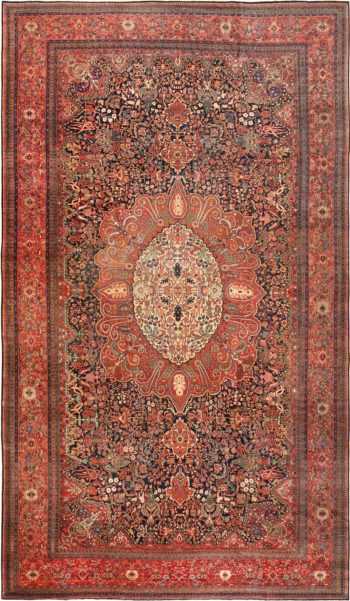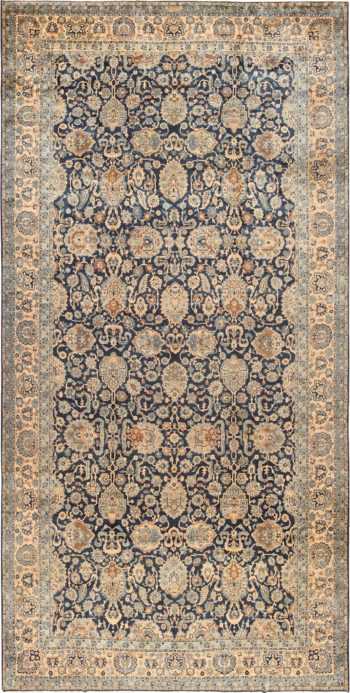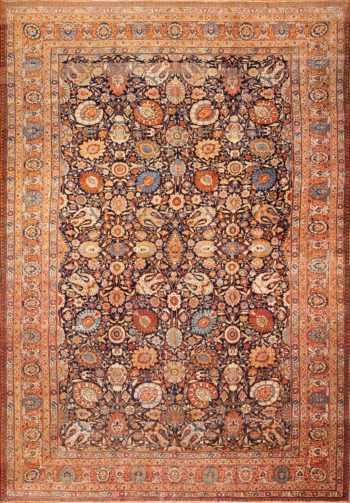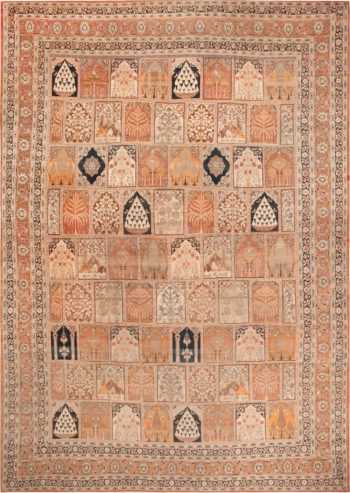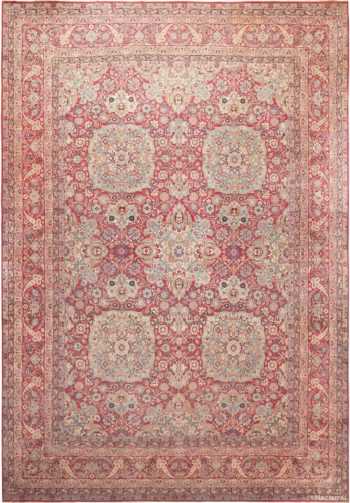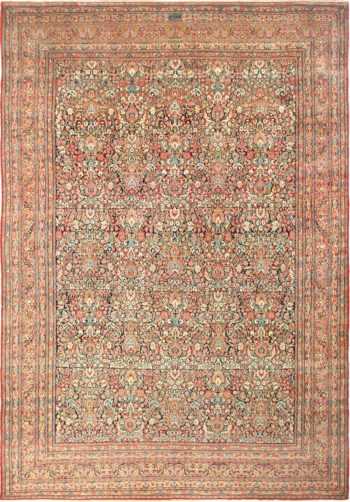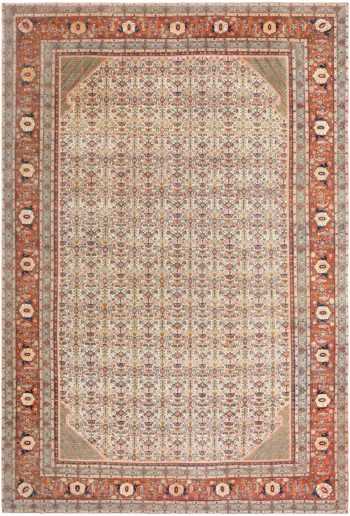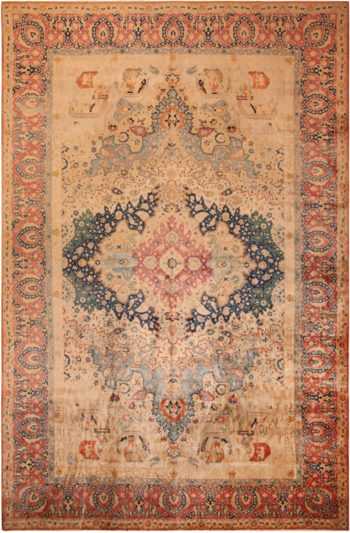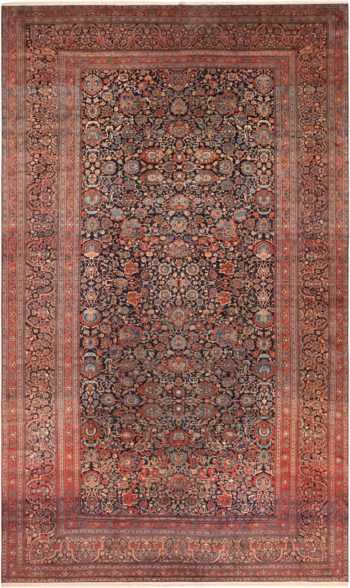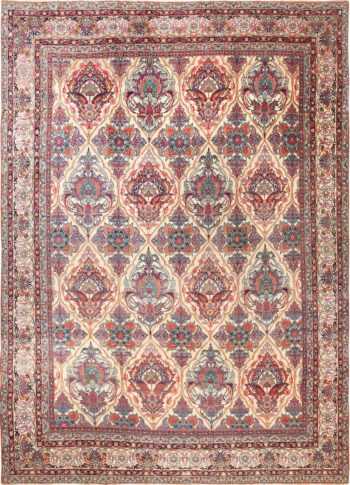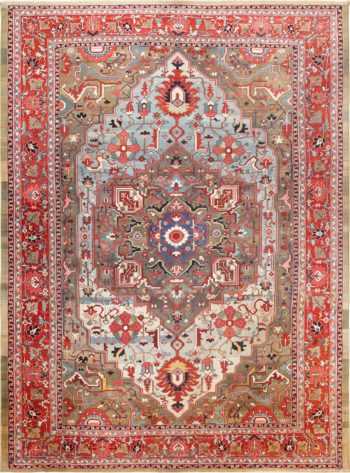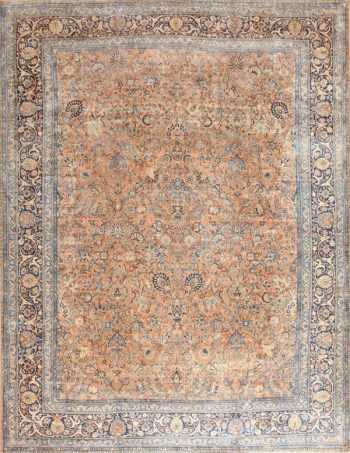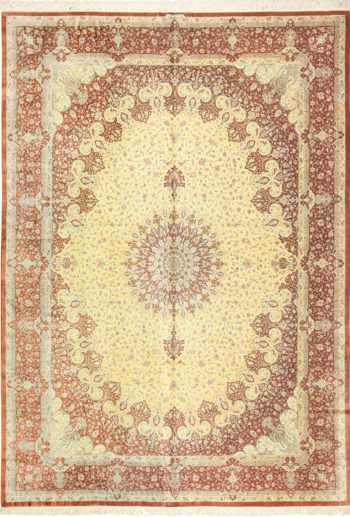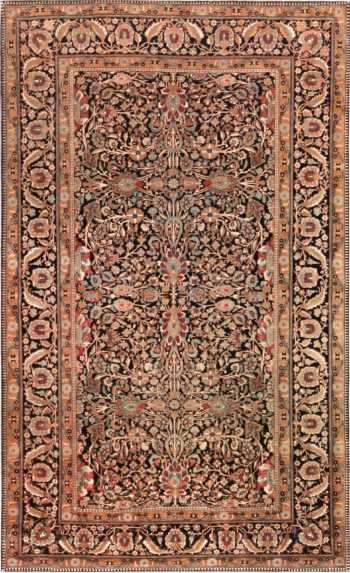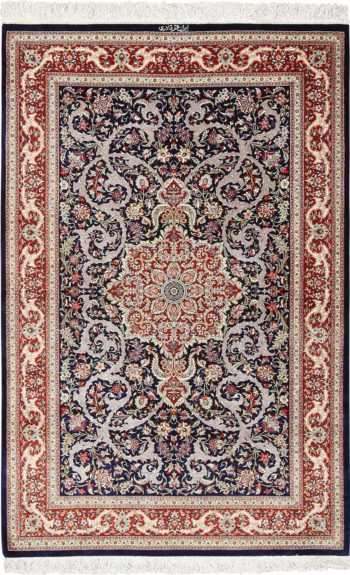Formal Rugs
Check out just some of our favorite formal rugs:
-
Fine Floral Animal Design Antique Oversized Persian Tabriz Rug 72518
$89,000.00Size: 17 ft x 24 ft 7 in (5.18 m x 7.49 m) -
Oversized Antique Persian Sarouk Farahan Rug 70266
$125,000.00Size: 13 ft 4 in x 23 ft 10 in (4.06 m x 7.26 m) -
Blue Background Large Scale Allover Design Oversized Antique Decorative Persian Kerman Rug 70932
$56,500.00Size: 11 ft 4 in x 22 ft 2 in (3.45 m x 6.76 m) -
Large Oversized Navy Blue Antique Persian Tabriz Rug 49375
$145,000.00Size: 14 ft 8 in x 22 ft (4.47 m x 6.71 m) -
Fine Beautiful Large Antique Persian Haji Jalili Tabriz Garden Design Rug 72070
$135,000.00Size: 14 ft 6 in x 20 ft (4.42 m x 6.1 m) -
Extremely Fine and Intricate Floral Large Antique Persian Kerman Rug 70942
$125,000.00Size: 14 ft 2 in x 19 ft 8 in (4.32 m x 5.99 m) -
Large Blue Background Classic Traditional Floral Design Antique Persian Khorassan Rug 49517
$32,000.00Size: 13 ft 3 in x 19 ft 2 in (4.04 m x 5.84 m) -
Finely Woven Large Size Beautiful Antique Ivory Haji Jalili Persian Tabriz Rug 48729
$46,000.00Size: 12 ft 10 in x 19 ft 2 in (3.91 m x 5.84 m) -
Beautiful Large Fine Weave Antique Decorative Persian Floral Medallion Tabriz Area Rug 71774
$38,500.00Size: 12 ft 6 in x 18 ft 10 in (3.81 m x 5.74 m) -
Fine High Quality Large Allover Floral Antique Blue Persian Mohtashem Kashan Rug 70951
$89,000.00Size: 11 ft x 18 ft 9 in (3.35 m x 5.71 m) -
Large Finely Woven Formal Jewel Tone Antique Persian Kerman Rug 70219
$96,000.00Size: 13 ft 6 in x 18 ft 9 in (4.11 m x 5.71 m) -
Large Jewel Tone Antique Persian Heriz Serapi Rug 49993
$94,000.00Size: 12 ft 6 in x 17 ft 6 in (3.81 m x 5.33 m) -
Large Antique Persian Kerman Area Rug 50411
$29,000.00Size: 11 ft 10 in x 15 ft 6 in (3.61 m x 4.72 m) -
Antique French Aubusson Square Floral Rug 70946
$38,000.00Size: 14 ft 8 in x 15 ft 2 in (4.47 m x 4.62 m) -
Fine Luxurious Silk Formal Medallion Room Size Persian Qum Rug 49398
$53,200.00Size: 9 ft 6 in x 13 ft 6 in (2.9 m x 4.11 m) -
Fine Luxurious Formal Antique Traditional Persian Mohtasham Kashan Rug 72114
$26,500.00Size: 4 ft 4 in x 6 ft 10 in (1.32 m x 2.08 m) -
Fine Small Scatter Size Formal Navy Blue Luxurious Silk Persian Qum Rug 49414
$3,850.00Size: 3 ft 4 in x 5 ft (1.02 m x 1.52 m)
Formal Rugs vs. Informal and Choosing a Rug and Interior Decoration
As a starting point, in the design world, what does “formal” actually mean?
In design, the term “formal” refers to a specific style or approach that is characterized by a sense of order, structure, and symmetry. A formal design typically adheres to established conventions and follows a set of rules or principles to create a balanced and harmonious composition.
Here are some key characteristics and elements associated with formal design:
- Symmetry: Formal designs often feature symmetrical arrangements, where elements are balanced on either side of a central axis. This creates a sense of order and stability.
- Regularity: Formal designs use regular shapes, patterns, and repetition to create a structured and predictable visual appearance. This can include geometric shapes, evenly spaced elements, and consistent patterns.
- Clear Hierarchy: There is a clear hierarchy of elements in a formal design, with some elements taking precedence over others. This hierarchy helps guide the viewer’s attention and understanding.
- Conservative Color Palettes: Formal designs often use conservative color palettes, with a focus on neutral colors and limited use of bold or contrasting hues. This contributes to a sense of elegance and sophistication.
- Precise Typography: Typography in formal design is typically well-organized and uses classic typefaces. Text is often aligned neatly and follows established typographic rules.
- Controlled White Space: White space (negative space) is carefully managed in formal designs to maintain a sense of balance and clarity. There is usually a clear separation between elements.
- High Attention to Detail: Formal designs pay close attention to detail, ensuring that every element is precisely positioned and aligned. This meticulous approach contributes to a polished and refined look.
- Traditional and Timeless: Formal design often draws inspiration from classical and traditional design principles, and it tends to have a timeless quality that doesn’t quickly go out of style.
Formal design is commonly used in contexts where a sense of professionalism, elegance, and orderliness is desired, such as corporate branding, high-end packaging, formal invitations, and traditional architecture. However, it’s important to note that design styles can evolve and adapt over time, so contemporary formal designs may incorporate elements of modernity and innovation while still maintaining a sense of formality and structure.
In the design world, what does “informal” actually mean?
In design, the term “informal” represents a style or approach that is characterized by a more relaxed, spontaneous, and unconventional aesthetic. Informal design intentionally departs from the strict rules and structured elements often associated with formal design.
Here are some key characteristics and elements commonly associated with informal design:
- Asymmetry: Informal designs often embrace asymmetry, where elements are not perfectly balanced and may appear in a more haphazard arrangement. This can create a sense of dynamic movement and informality.
- Irregularity: Informal designs may incorporate irregular shapes, patterns, and compositions, often avoiding strict adherence to geometric forms and regular spacing.
- Playful Colors: Informal designs tend to use a wider range of colors, including bold and contrasting hues. The color choices can be more eclectic and whimsical, adding vibrancy and energy to the design.
- Organic and Handmade Elements: Informal design often incorporates organic and handmade elements, such as hand-drawn illustrations, brush strokes, or irregular textures. These imperfections contribute to a more relaxed and humanistic feel.
- Varied Typography: Typography in informal design may feature a mix of fonts, sizes, and styles. It can include handwritten or script fonts to convey a more personal and casual tone.
- Relaxed White Space: Informal designs may utilize white space in a more relaxed and less structured manner, allowing for a freer flow of elements and a more open, airy appearance.
- Expressive and Unconventional Layouts: Informal designs may experiment with unconventional layouts, positioning elements in unique and unexpected ways. This can create a sense of creativity and informality.
- Contemporary and Trend-Driven: Informal design styles often align with current design trends and may incorporate modern design elements to maintain a fresh and contemporary look.
- Informal Mood and Tone: Overall, informal design aims to convey a mood or tone that is casual, approachable, and friendly. It often strives to connect with the audience on a personal level.
Informal design is commonly used in contexts where a less rigid and more approachable feel is desired, such as in marketing materials for youth-oriented brands, casual dining establishments, blogs, and creative arts and crafts projects. It can help convey a sense of personality and authenticity while breaking away from the formality and structure of more traditional design styles.
Shopping For Formal and / or Informal Area Rugs
There are a myriad of reasons why a particular individual may be in the market for an antique rug, whether they are searching for formal rugs or informal rugs. And the selection and variety of fine antique rugs and carpets in our extensive collection is just as varied.
At the end of the day, however, interior decor essentially falls into two categories – the formal and the informal. Formal rugs and informal rugs differ from one another in much the same way as formal and informal examples of any other art form.
Antique rugs that convey formality are generally those produced in sophisticated urban settings. In the Orient this means Persian, Indian, and Turkish city rugs with sinuous, finely detailed arabesque designs. In the west this means the classical elegance of Aubusson, Savonnerie, Axminster, and Spanish carpets, but also Art Deco rugs with a modernist emphasis.
Oriental rugs that lend themselves to informal settings are primarily tribal and village rugs with simple geometric designs, whether from Persia, the Caucasus, and Turkey, or nomadic Central Asian rugs. Turkoman or Bokara rugs, with precise, geometric patterns, however, straddle this divide.
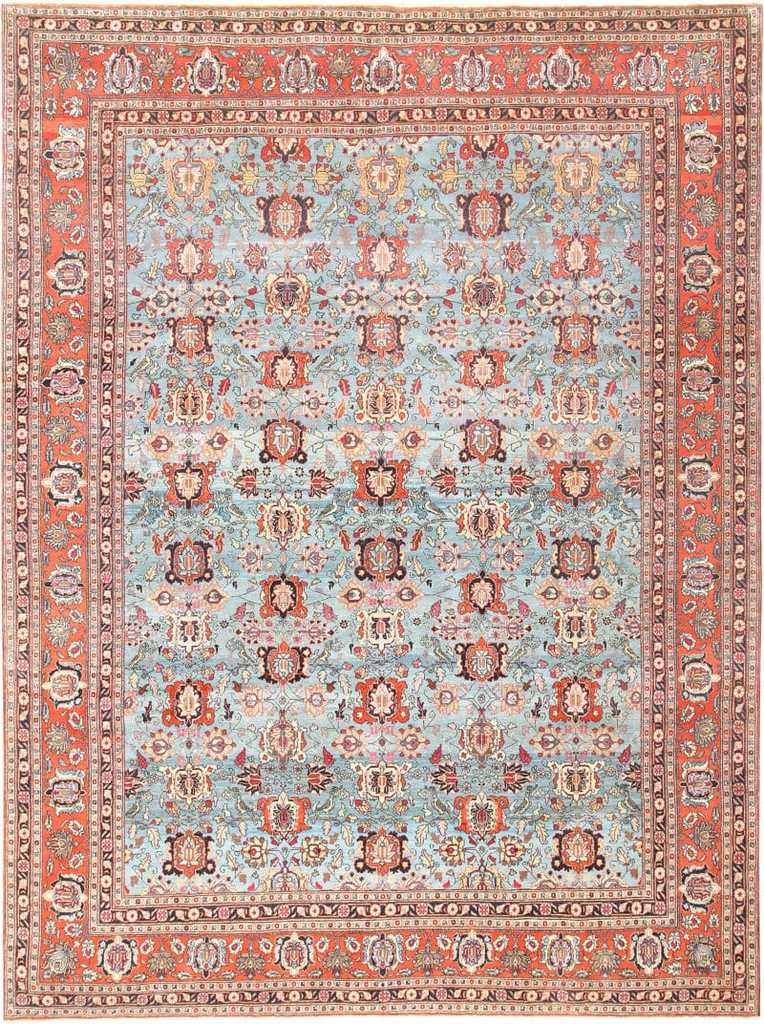
Formal Rugs vs. Informal
In a high-powered business space, meanwhile, formality is more appropriate. In rooms where one meets clients, board rooms, and the like, it is safer to error the sire of the formal, and to enhance spaces like this with more refined rugs and carpets. In residential space, foyers, living, and dining rooms may require formality, and perhaps libraries as well. Informal rugs work well in more relaxed business environments.
For home decor informal pieces are generally appropriate to dens, family rooms, bedrooms. But once again, personal taste is the bottom line. Some clients want formality virtually everywhere, while others prefer informality throughout their residence.
View our Consumer Guide to Buying Rugs for more information.
Choosing Formal Rugs For Formal Interior Designs
When you walk into a room, the carpet is often the feature that draws your attention first. You may be drawn to a certain piece of furniture, or perhaps wallpaper color, but it is the carpet that first sets the tone of the room. For this reason, the carpet is perhaps the most important piece for interior design.
A carpet either ties the room together or makes it look out of place and disconnected. This is especially true with antique Persian carpets of exquisite design and vibrant color combinations. Perhaps a solid-color, muted-tone carpet produced by a modern manufacturer could blend in with the paint color and go unnoticed, but an oriental carpet was not made to blend in. These carpets were made to stand out, and that is why it is important to select the right one to set the tone of the room.
The Right Formal Rugs for the Formal Interior
People have many different choices in the world of interior design today. Interior designers have moved away from the one-size-fits-all approach of the past when one style tended to dominate trends. Today’s interior design encourages you to express your taste and express your more artistic side. A hand-knotted carpet is a perfect way to express your individuality within the design because there are so many different designs and styles available.
Most interior designs can be classified into the broad categories of formal or informal. When you think of a formal design, you may think of a historical theme, classic furniture, minimalist, or Asian styles. When you think of an informal design, terms like Bohemian, eclectic, organic, tribal, and fusion styles come to mind. It is important to choose a carpet that fits the overall design tone of the room. Otherwise, it can look out of place and make the design lose focus.

A Mohtasham Kashan formal rug.
Choosing Formal Rugs
The world of knotted pile rugs makes it easy to choose formal and informal designs. When one thinks of an informal design, they usually think of a tribal carpet or one produced in a remote village. Often, these carpets have characteristics that make them have a “handmade” look. They may have inconsistencies in color, they may not be symmetrical, and it may look as if one person started the rug and another person finished it. The design is not always consistent, and sometimes the lines and edges are not straight. These rustic qualities are what make them perfect for an informal design setting. They can be compared to folk-art, as opposed to the work of a formally schooled artist. Both have their perfect place in the design world.
An antique Persian rug is what most people think of when they think of formal rugs. These antique rugs were produced in the traditional weaving centers of the world with names like Tabriz, Sultanabad, and Kerman. They were held to high-quality standards, and the designs were carefully laid out on a pattern called a rug cartoon. Master weavers had to train for many years to be able to produce these beautiful rugs. Many of these designers became famous, and their designs are recognizable. It is easy to spot formal rugs made by a master weaver such as Mohtasham, Farahan, or Haji Jalili.
A formal carpet pays strict attention to symmetry and placement of color. They show the result of a trained eye and attention to detail. The symbols and motifs are carried out with perfection. The knots are even and the pile is perfectly cut. Whether the carpet was produced in the 16th century or the 21st century, the carpets produced in the weaving centers were held to strict quality standards. They represent the best of the best when it comes to design and technical weaving skills.
This contrasts with the setting in the tribal village where the pattern was often handed down orally, sometimes through song. They represent the individual artistic expression of the weaver more so than the formal carpets produced in the cities. Sometimes it appears as if the weaver was following no pattern at all, other than the memorized motifs, which can appear to be randomly incorporated into the carpet. They are more suitable for a completely different interior design setting than the formal carpets of the cities.
One of the best parts about antique Oriental rugs is that you have so many options to choose from. If your room design is formal and requires a carpet that can carry this theme, then a carpet produced in the major carpet cities will be your best choice. These city carpets were produced with extra care and are from some of the most highly skilled rug weavers in the world. The precision and artistry are apparent when you see one. They also often have higher knot counts and therefore, more intricate details.
If you have a particular color scheme for design and mind, Nazmiyal has an extensive collection from which to choose. Sometimes, customers will fall in love with a specific carpet and then build the remainder of the interior design around it. Whichever method you choose, we have a wide selection of formal carpets from some of the best-known, world-class masters of the trade. Whether you are looking for a historical treasure from the 17th century or mid-century modern design, you are sure to find something to suit your taste.
Learn more about: Formal vs. Informal Rugs


